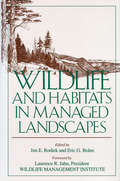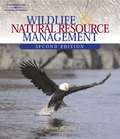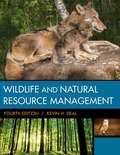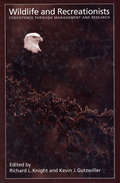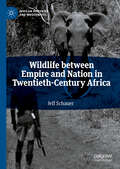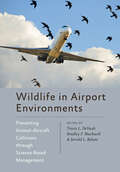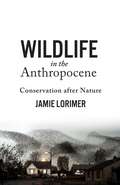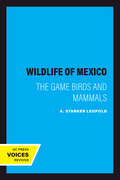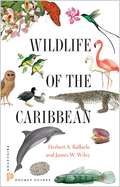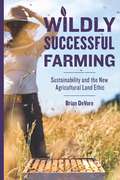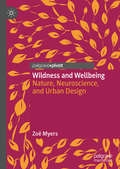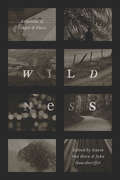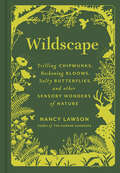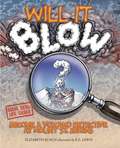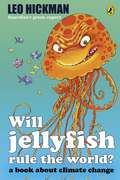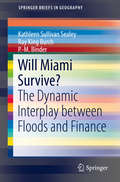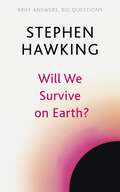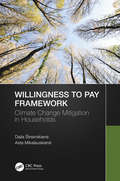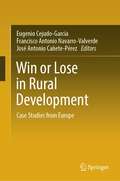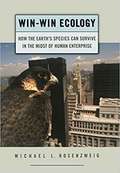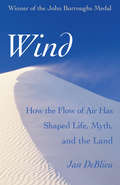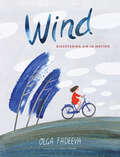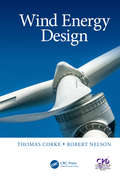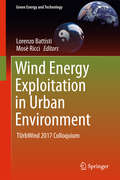- Table View
- List View
Wildlife and Habitats in Managed Landscapes
by Eric Bolen Jon RodiekAmericans are having an increasing impact on the rural landscape as development further encroaches in former wilderness areas. This disruptive land use is causing a decline in wildlife and wildlife habitats. Wildlife and Habitats in Managed Landscapes presents a new strategy for solving this problem by redefining habitats to include the concept of landscape. Employing this strategy, natural resource managers apply tools of planning, management, and design to entire landscapes to meet the needs of both wildlife and humans.
Wildlife and Natural Resource Management
by Kevin H. DealFor agricultural extension professionals, nature conservatory staff and others, this book offers complete coverage of a very complex subject. Wildlife and Natural Resource Management provides detailed, in-depth looks at many subjects such as: the history of wildlife conservation in America, the history of modern wildlife and fisheries management, the various federal and state agencies responsible for wildlife and fisheries management, the financing of wildlife conservation in America, and the numerous private conservation organizations are all discussed in detail. Wildlife and Natural Resource Management also provides a look at fossil fuels, their role in our society and their conservation, as well as discussing soil, forest, and water management and conservation. The habitat requirements, feeding and breeding habits of most species of native fauna are discussed. Descriptions and ranges are covered with photos where possible. Endangered species and the Endangered Species Act and its effect of endangered species are also covered. The glossary and appendices are complete to be useful to the student. While a tremendous amount of information is presented between the covers, it is written in such a way as to be easy to read and hold the reader's attention.
Wildlife and Recreationists: Coexistence Through Management And Research
by Joanna Burger Daniel J. Decker Richard L. Knight Kevin Gutzwiller H. Ken Cordell Paul KerlingerWildlife and Recreationists defines and clarifies the issues surrounding the conflict between outdoor recreation and the health and well-being of wildlife and ecosystems. Contributors to the volume consider both direct and indirect effects of widlife-recreationist interactions, including: *wildlife responses to disturbance, and the origins of these responses *how specific recreational activities affect diverse types of wildlife *the human dimensions of managing recreationists *the economic importance of outdoor recreation *how wildlife and recreationists might be able to coexist The book is a useful synthesis of what is known concerning wildlife and recreation. More important, it addresses both research needs and management options to minimize conflicts.
Wildlife between Empire and Nation in Twentieth-Century Africa (African Histories and Modernities)
by Jeff SchauerThis book traces the emergence of wildlife policy in colonial eastern and central Africa over the course of a century. Spanning from imperial conquest through the consolidation of colonial rule, the rise of nationalism, and the emergence of neocolonial and neoliberal institutions, this book shows how these fundamental themes of the twentieth century shaped the relationships between humans and animals in what are today Kenya, Tanzania, Uganda, Zambia, and Malawi. A set of key themes emerges—changing administrative forms, militarization, nationalism, science, and a relentlessly broadening constituency for wildlife. Jeff Schauer illuminates how each of these developments were contingent upon the colonial experience, and how they fashioned a web of structures for understanding and governing wildlife in Africa—one which has lasted into the twenty-first century.
Wildlife in Airport Environments: Preventing Animal–Aircraft Collisions through Science-Based Management (Wildlife Management and Conservation)
by Travis L. DeVault Bradley F. Blackwell Jerrold L. BelantA comprehensive overview of wildlife issues facing airports and how to minimize conflicts.Winner of the NWRC Publication Award of the National Wildlife Research CenterThe pilot watches the instrument panel and prepares for touchdown—a routine landing until a burst of birds, a coyote, or a herd of deer crosses the runway! Every year, pilots experience this tension and many aircraft come into direct contact with birds and other wildlife, resulting in more than one billion dollars in damage annually. The United States Federal Aviation Administration has recorded a rise in these incidents over the past decade due to the combined effects of more reporting, rebounding wildlife populations, and an increased number of flights. Wildlife in Airport Environments tackles the issue of what to do about encounters with wildlife in and around airports—from rural, small-craft airparks to major international hubs. Whether the problem is birds or bats in the flight path or a moose on the runway, the authors provide a thorough overview of the science behind wildlife management at airports. This well-written, carefully documented volume presents a clear synthesis for researchers, wildlife managers, and airport professionals. The book belongs in the hands of all those charged with minimizing the risks that wildlife pose to air travel.Wildlife in Airport Environments is the first book in the series Wildlife Management and Conservation and is published in association with The Wildlife Society.ContributorsMichael L. Avery, U.S. Department of AgricultureJerrold L. Belant, Mississippi State UniversityKristin M. Biondi, Mississippi State UniversityBradley F. Blackwell, U.S. Department of AgricultureJonathon D. Cepek, U.S. Department of AgricultureLarry Clark, U.S. Department of AgricultureTara J. Conkling, Mississippi State UniversityScott R. Craven, University of Wisconsin–MadisonPaul D. Curtis, Cornell UniversityTravis L. DeVault, U.S. Department of AgricultureRichard A. Dolbeer, U.S. Department of AgricultureDavid Felstul, U.S. Department of the InteriorEsteban Fernández-Juricic, Purdue UniversityAlan B. Franklin, U.S. Department of AgricultureSidney A. Gauthreaux Jr., Clemson UniversityMichael Lavelle, U.S. Department of AgricultureJames A. Martin, Mississippi State UniversityRebecca Mihalco, U.S. Department of AgriculturePaige M. Schmidt, U.S. Fish and Wildlife ServiceThomas W. Seamans, U.S. Department of AgricultureKurt C. VerCauteren, U.S. Department of AgricultureBrian E. Washburn, U.S. Department of Agriculture
Wildlife in the Anthropocene: Conservation after Nature
by Jamie LorimerElephants rarely breed in captivity and are not considered domesticated, yet they interact with people regularly and adapt to various environments. Too social and sagacious to be objects, too strange to be human, too captive to truly be wild, but too wild to be domesticated—where do elephants fall in our understanding of nature? In Wildlife in the Anthropocene, Jamie Lorimer argues that the idea of nature as a pure and timeless place characterized by the absence of humans has come to an end. But life goes on. Wildlife inhabits everywhere and is on the move; Lorimer proposes the concept of wildlife as a replacement for nature. Offering a thorough appraisal of the Anthropocene—an era in which human actions affect and influence all life and all systems on our planet— Lorimer unpacks its implications for changing definitions of nature and the politics of wildlife conservation. Wildlife in the Anthropocene examines rewilding, the impacts of wildlife films, human relationships with charismatic species, and urban wildlife. Analyzing scientific papers, policy documents, and popular media, as well as a decade of fieldwork, Lorimer explores the new interconnections between science, politics, and neoliberal capitalism that the Anthropocene demands of wildlife conservation. Imagining conservation in a world where humans are geological actors entangled within and responsible for powerful, unstable, and unpredictable planetary forces, this work nurtures a future environmentalism that is more hopeful and democratic.
Wildlife of Mexico: The Game Birds and Mammals
by A. Starker LeopoldThis title is part of UC Press's Voices Revived program, which commemorates University of California Press’s mission to seek out and cultivate the brightest minds and give them voice, reach, and impact. Drawing on a backlist dating to 1893, Voices Revived makes high-quality, peer-reviewed scholarship accessible once again using print-on-demand technology. This title was originally published in 1959.
Wildlife of the Caribbean (Princeton Pocket Guides)
by James Wiley Herbert RaffaeleThis is the first comprehensive illustrated guide to the natural world of the Caribbean islands. It contains 600 vivid color images featuring 451 species of plants, birds, mammals, fish, seashells, and much more. While the guide primarily looks at the most conspicuous and widespread species among the islands, it also includes rarely seen creatures―such as the Rhinoceros Iguana and Cuban Solenodon―giving readers a special sense of the region's diverse wildlife. <p><p> Each species is represented by one or more color photos or illustrations; details regarding its identification, status, and distribution; and interesting aspects of its life history or relationship to humans. In addition, an introductory section focuses on the unique characteristics of the Caribbean’s fauna and flora, the threats faced by both, and some of the steps being taken to sustain the area’s extraordinary natural heritage.
Wildly Successful Farming: Sustainability and the New Agricultural Land Ethic
by Brian DeVoreWildly Successful Farming tells the stories of farmers across the American Midwest who are balancing profitability and food production with environmental sustainability and a passion for all things wild. They are using innovative techniques and strategies to develop their "wildly" successful farms as working ecosystems. Whether producing grain, vegetables, fruit, meat, or milk, these next-generation agrarians look beyond the bottom line of the spreadsheet to the biological activity on the land as key measures of success. Written by agricultural journalist Brian DeVore, the book is based on interviews he has conducted at farms, wildlife refuges, laboratories, test plots, and gardens over the past twenty-five years. He documents innovations in cover cropping, managed rotational grazing, perennial polyculture, and integrated pest management. His accounts provide insight into the impacts regenerative farming methods can have on wildlife, water, landscape, soils, and rural communities and suggest ways all of us can support wildly successful farmers.
Wildness and Wellbeing: Nature, Neuroscience, and Urban Design
by Zoë MyersWildness and Wellbeing explores the dynamic relationships between urban nature and mental health, offering practical strategies for urban design. Mental health is a leading global issue and our urban environments can contribute to conditions such as depression and anxiety. Presenting the latest research, this book explores how neuroscience can offer new perspectives on the crucial role everyday multisensory interactions with nature can have on our mental wellbeing. These insights can help us (un)design our streets, neighbourhoods and cities, allowing nature to be integrated back into our cities. Wildness and Wellbeing is for anyone interested in the connections between urban ecology, health, environmental science, planning, and urban design, helping to create biodiverse cities for mental health.
Wildness: Relations of People & Place
by John Hausdoerffer Gavin Van Horn and John HausdoerfferWhether referring to a place, a nonhuman animal or plant, or a state of mind, wild indicates autonomy and agency, a will to be, a unique expression of life. Yet two contrasting ideas about wild nature permeate contemporary discussions: either that nature is most wild in the absence of a defiling human presence, or that nature is completely humanized and nothing is truly wild. This book charts a different path. Exploring how people can become attuned to the wild community of life and also contribute to the well-being of the wild places in which we live, work, and play, Wildness brings together esteemed authors from a variety of landscapes, cultures, and backgrounds to share their stories about the interdependence of everyday human lifeways and wildness. As they show, far from being an all or nothing proposition, wildness exists in variations and degrees that range from cultivated soils to multigenerational forests to sunflowers pushing through cracks in a city alley. Spanning diverse geographies, these essays celebrate the continuum of wildness, revealing the many ways in which human communities can nurture, adapt to, and thrive alongside their wild nonhuman kin. From the contoured lands of Wisconsin’s Driftless region to remote Alaska, from the amazing adaptations of animals and plants living in the concrete jungle to indigenous lands and harvest ceremonies, from backyards to reclaimed urban industrial sites, from microcosms to bioregions and atmospheres, manifestations of wildness are everywhere. With this book, we gain insight into what wildness is and could be, as well as how it might be recovered in our lives—and with it, how we might unearth a more profound, wilder understanding of what it means to be human.Wildness: Relations of People and Place is published in association with the Center for Humans and Nature, an organization that brings together some of the brightest minds to explore and promote human responsibilities to each other and the whole community of life. Visit the Center for Humans and Nature's Wildness website for upcoming events and a series of related short films.
Wildscape: Trilling Chipmunks, Beckoning Blooms, Salty Butterflies, and other Sensory Wonders of Nature
by Nancy LawsonFrom Nancy Lawson, author of The Humane Gardener, a first-of-its-kind guide that takes readers on an insightful and personal exploration of the secret lives of animals and plants.Master naturalist Nancy Lawson takes readers on a fascinating tour of the vibrant web of nature outside our back door—where animals and plants perceive and communicate using marvelous sensory abilities we are only beginning to understand. Organized into chapters investigating each of their five senses, Lawson's exploration reveals a remarkable world of interdependent creatures with amazing capabilitiesYou'll learn of ultrasound clicks humans can't hear, and ultraviolet colors humans can't see. You'll cross paths with foraging American bumblebees drawn to the scent of wild bergamot, urban sparrows who adapt their mating song in response to human clamor, trees that amp up their growth in response to deer and moose saliva, and a chipmunk behaving like the world's smallest pole vaulter to nab juicy red berries hanging from the lowest parts of a coral honeysuckle vine.Synthesizing cutting-edge scientific research, original interviews with animal and plant researchers, and poetic observations made in her own garden, Lawson shows us how to appreciate the natural environment from the sensory perspective of our wild neighbors right outside our door and beyond, and how to respect and nurture the habitats they need to survive.
Will It Blow?: Become a Volcano Detective at Mount St. Helens
by Elizabeth RuschThis book helps the reader to become a volcano detective who can decipher volcanic clues,with real life cases from Mount St. Helens.
Will Jellyfish Rule the World?: A Book About Climate Change
by Leo HickmanFrom what makes Earth so special, to how scientists know for sure our climate is changing, why it's a big deal for everyone and what we can all do right now to make a difference, green expert Leo Hickman is ready to answer all your questions.Will Jellyfish Rule the World? breaks down the causes and effects of climate change in a fresh, fun and easy-to-follow format. Packed with practical everyday things we can all do right now to make a difference, Will Jellyfish Rule the World? is a comprehensive, easy-to-use eco-handbook for budding classroom environmentalists everywhere.
Will Miami Survive?: The Dynamic Interplay Between Floods And Finance (SpringerBriefs in Geography)
by P. M. Binder Kathleen Sullivan Sealey Ray King BurchThis SpringerBrief uses a complexity perspective to integrate risk, finance, and ecological issues in Miami, USA. It focuses on how the modern financial system, particularly the mortgage market, perceives and manages the risk of climate change. Authors Kathleen Sealey, Ray King Burch and P.-M. Binder offer the case study of South Florida to illustrate how landscapes can be either re-purposed to function ecologically when residents relocate or rebuilt to reduce the threat of future flooding, the tools needed to make these decisions, and how financial systems view and influence them. While the need to integrate financial markets into coastal (and environmental) management is increasingly recognized, the difficulty of this task is made greater by the speed of financial innovation and the obscurity and complexity of its practices. This book will discuss the innovative Southeast Florida Regional Climate Compact, and the success of public-private partnerships in planning and adapting to sea level rise, but also the broad disconnect with the cash-and-credit-driven real estate market of South Florida. The book presents an interdisciplinary approach to the understanding of the coupled human (including finance) and natural systems in coastal cities, thus breaking new ground in the approach towards sustainability research and education. The final chapter introduces the social component of resilience which include pre-disaster outreach with and the potential for decision theory to help people understand and manage risk.
Will We Survive on Earth? (Brief Answers, Big Questions)
by Stephen Hawking'Be brave, be curious, be determined, overcome the odds. It can be done'Will we survive on Earth?Should we colonise space?Throughout his extraordinary career, Stephen Hawking expanded our understanding of the universe and unravelled some of its greatest mysteries. In Will We Survive on Earth? the world-famous cosmologist and bestselling author of A Brief History of Time turns his attention to one of the most urgent issues for humankind and explores our options for survival.'Effortlessly instructive, absorbing and witty' GuardianBrief Answers, Big Questions: this stunning paperback series offers electrifying essays from one of the greatest minds of our age, taken from the original text of the No. 1 bestselling Brief Answers to the Big Questions.
Willingness to Pay Framework: Climate Change Mitigation in Households
by Dalia Štreimikienė Asta MikalauskienėThis book aims to develop a framework for the assessment of population ‘preferences in climate change mitigation policies by applying a Willingness to Pay (WTP) approach and presents the results from several case studies in Lithuania on renewable energy generation and renovation in different households. These analyses of climate change mitigation policies and measures, based on the assessment of their effectiveness, provide recommendations for developing innovative measures in other countries. Since public preferences are variable, climate change mitigation policies can change these preferences and allow to form new ones. Features: Analyses social benefits of climate change mitigation measures and their integration methods based on assessment of public preferences. Presents several practical case studies on energy needs where the Willingness to Pay framework was applied. Discusses climate change mitigation barriers in energy sector and the effectiveness of climate change mitigation policies to overcome them. Provides a novel approach for climate change mitigation policies development in households. Includes useful information for evaluating and planning policies related to renewable energy investment. This book is a useful reference for those in the academic, research, and business communities, policy makers, graduate students, and professionals involved with climate change mitigation projects.
Willy Ley's Exotic Zoology
by Willy LeyThe extremely diverse inhabitants of Willy Ley's extraordinary zoo all have one thing in common: there is or has been a mystery about them. But Willy doesn't just describe the animals or the mystery, he also digs deep in the records and stories about those mysteries to solve as many as possible--from fabled unicorns and mermaids, to when we realized dinosaurs were real, to the ever charming dodo, to real monsters of the sea and beyond.
Win or Lose in Rural Development: Case Studies from Europe
by Eugenio Cejudo-García Francisco Antonio Navarro-Valverde José Antonio Cañete-PérezThe aims of this book are: systematization and theorization of these projects; clarify and deepen the social and territorial effects of these initiatives; in-depth study of the causes that lead to the generation of successful projects in rural development; and abound in the reasons that lead specific projects to be failed in the access to LEADER support and be finally not implemented. This process of systematization and theorization would contribute to improving the decision-making in rural development, concretely the practice of these policies and initiatives. The book shows the problems, results and best practices that cause the rural development in different areas along with Europe. The multidisciplinary and international character of the authors in the analysis of rural development will enrich the publication and facilitate the different and critical reflections on the contributions, errors and meaning of these rural development practices.
Win-Win Ecology: How the Earth's Species Can Survive In the Midst of Human Enterprise
by Michael L. RosenzweigAs humanity presses down inexorably on the natural world, people debate the extent to which we can save the Earth's millions of different species without sacrificing human economic welfare. But is this argument wise? Must the human and natural worlds be adversaries? In this book, ecologist Michael Rosenzweig finds that ecological science actually rejects such polarization. Instead it suggests that, to be successful, conservation must discover how we can blend a rich natural world into the world of economic activity. This revolutionary, common ground between development and conservation is called reconciliation ecology: creating and maintaining species-friendly habitats in the very places where people live, work, or play. The book offers many inspiring examples of the good results already achieved. The Nature Conservancy, for instance, has a cooperative agreement with the Department of Defense, with more than 200 conservation projects taking place on more than 170 bases in 41 states. In places such as Elgin Air Force Base, the human uses-testing munitions, profitable timbering and recreation--continue, but populations of several threatened species on the base, such as the long-leaf pine and the red-cockaded woodpecker, have been greatly improved. The Safe Harbor strategy of the Fish & Wildlife Service encourages private landowners to improve their property for endangered species, thus overcoming the unintended negative aspects of the Endangered Species Act. And Golden Gate Park, which began as a system of sand dunes, has become, through human effort, a world of ponds and shrubs, waterfowl and trees. Rosenzweig shows that reconciliation ecology is the missing tool of conservation, the practical, scientifically based approach that, when added to the rest, will solve the problem of preserving Earth's species.
Wind
by Jan DeblieuThe wind has sculpted Earth from the beginning of time, but it has also shaped humans--our histories, religions and cultures, the way we build our dwellings, and how we think and feel. In this poetic, acclaimed work, Jan DeBlieu takes the tempests of her home, the North Carolina Outer Banks, as a starting point for considering how the world's breezes and gales have made us who we are. She travels widely, seeking out the scientists, sailors and sages who, like her, are haunted by the movement of air.
Wind
by Olga FadeevaA browsable, appealing introduction to an important weather phenomenon.If your hair has ever blown back on a breezy day, you&’ve noticed the wind at work. But what causes the wind? Are there different types of wind? How do we measure and name them? How does the wind shape our ecosystems, plants, and animals? What about people: how have human beings used the wind in the past and the present? Can you really sail into the wind, and would a tailwind help or hurt your plane&’s takeoff? Up, up beyond the clouds, does the wind affect other planets, too? Created with help from a meteorologist, this beautiful book is a fascinating exploration of the wind&’s role in world history and earth science. Playful prose and colorful illustrations invite children to bring their questions along as they learn more about this powerful—but sometimes overlooked—natural element.
Wind Energy Design
by Robert Nelson Thomas CorkeWind Energy Systems is designed for undergraduate engineering courses, with a focus on multidisciplinary design of a wind energy system. The text covers basic wind power concepts and components - wind characteristics and modeling, rotor aerodynamics, lightweight flexible structures, wind farms, aerodynamics, wind turbine control, acoustics, energy storage, and economics. These topics are applied to produce a new conceptual wind energy design, showing the interplay of various design aspects in a complete system. An ongoing case study demonstrates the integration of various component topics, and MATLAB examples are included to show computerized design analysis procedures and techniques.
Wind Energy Exploitation in Urban Environment: Turbwind 2017 Colloquium (Green Energy And Technology)
by Lorenzo Battisti Mosè RicciThis book presents numerical and experimental research in the field of wind energy exploitation in urban environments. It comprises a selection of the best papers from the international colloquium “Research and Innovation on Wind Energy Exploitation in Urban Environment” (TUrbWind), held in Riva del Garda, Italy in June 2017. The book includes contributions from different research fields in urban wind resources, wind energy conversion systems, and urban integration, mainly focusing on the following topics: · concepts for urban and open landscape micro wind turbines, · integration of micro wind turbines in existing structures, · built-environment and high-turbulence sites’ impacts on urban wind turbines, · measuring and modeling wind resource in built environments, · rotor performance and wake features of micro wind turbines. It is a valuable resource for researchers and practitioners interested in the integration of wind energy systems and turbines in urban areas.
